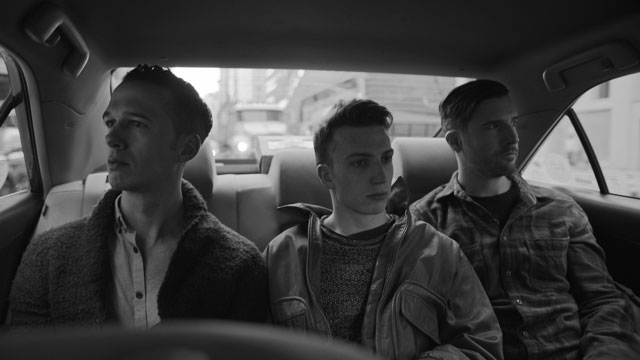February 18, 2020
by Carla Hay

Directed by Ryan Lonergan
Culture Representation: Taking place during a road trip that starts in New York City and ends up in Los Angeles, the satirical drama “Kill the Monsters” has a predominantly white LGBTQ cast of characters doing a modern re-enactment of key points in U.S. history.
Culture Clash: The three main characters represent the United States, while other characters portray various entities that have had conflicts with the U.S.
Culture Audience: This movie will appeal mostly to audiences who are looking for unique LGBTQ stories and people who are U.S. history buffs.

What do you get when you cross a gay threesome with U.S. history lessons? You get the audacious and all-over-the-place satirical drama “Kill the Monsters,” which is made for people who won’t be offended by the idea that three men who have hot’n’heavy gay sex with each other are a metaphor for the United States. It’s a unique concept that works best if viewers really know U.S. history. Otherwise, too much of the story (which is subtitled “An American Allegory”) will be confusing.
Filmed entirely in black and white, “Kill the Monsters” is divided into nine chapters that represent pivotal moments in U.S. history. At the center of the story are three characters who are in a ménage à trois relationship: Patrick (played by Ryan Lonergan) is the sensible and bossy alpha male; Sutton (played by Garrett McKechnie) is the hedonistic partier; and Frankie (played by Jack Ball) is their younger idealistic partner. In order to fully understand this movie, it helps to know from the beginning that Patrick, Sutton and Frankie represent the United States. If not, then only a keen knowledge of U.S. history will help you understand what’s going on during the course of the movie.
“Kill the Monsters” is the feature-film directorial debut of Lonergan, who also wrote the movie’s screenplay. His Patrick character also has the snappiest dialogue in the movie, which has a lot of people talking as if they’re amped up on caffeine or a drug that’s a lot stronger. There are also quick edits and jump cuts that can be somewhat distracting. Clocking in at just 77 minutes, “Kill the Monsters” is a movie that doesn’t give much time for people to digest a scene before moving on to the next scene. In contrast to the modernist short-attention-span editing techniques, the film’s pomp-and-circumstance classical score (with music by Jean Sibelius Music and performed by Iceland Symphony Orchestra) is the kind of music that sounds like it would be in a history documentary.
The movie’s production notes don’t really say which aspects of the United States that Patrick, Sutton and Frankie are supposed to represent, but at the beginning of the film, there’s a hypothetical quote from Benjamin Franklin: “Democracy is two wolves and a lamb voting on what to have for dinner.” The quote is shown after an intro scene in New York City’s Central Park, with Patrick and Sutton walking toward Frankie, who’s lying down on a blanket.
One could easily make a case for this theory: The three central characters are symbols for “life, liberty and the pursuit of happiness,” one of the best-known phrases from the U.S. Declaration of Independence. Patrick represents life, because he’s the engine that drives a lot of what happens in the three-way relationship. Sutton represents liberty because he’s a free-spirited libertine with decadent ways. Frankie represents the pursuit of happiness, since he has a youthful restlessness that make the other two partners think he might get bored with them and move on to something else that will make him happy. Or maybe that’s overthinking it all, and Lonergan just wanted an excuse to do a movie with full-frontal male nudity and showing three men having sex with each other in several scenes.
In the beginning of the film (the first chapter, titled “1776”), Patrick, Sutton and Frankie are living together in New York City. Frankie is working for an older British woman, who’s difficult and overbearing, so he ends up quitting. This is obviously a representation of the United States declaring its independence from the United Kingdom. Throughout the story, Frankie is battling a mysterious ailment (he’s seen at a doctor’s office), which represents the various social ills that the U.S. has faced throughout the country’s history.
Frankie wants to move west to California because he thinks that will improve his health. Patrick doesn’t really want to move, but Sutton is fine with the idea. So the three men leave New York City and decide they’ll move west by going on a road trip. Frankie also says that the doctor has increased his medications. This happens in the movie’s second chapter, titled “1803,” which represents when the U.S. expanded its territory with the Louisiana Purchase.
The third chapter, titled “1861,” signals the start of the U.S. civil war. And there’s a civil war brewing in this polyamorous relationship. Sutton is abusing cocaine and marijuana. Patrick doesn’t like it and argues with him about his drug use. Patrick gets even more upset when Sutton tells him that he wants Frankie to do drugs with him.
The other chapters cover 1865, the year the Civil War ended; the Compromise of 1877; the beginning of reparations/restitutions in 1900; America’s first full year in World War II in 1942; the end of World War II in 1945; the 9/11 attacks in 2001; and President Donald Trump’s first year in office in 2017.
All of the other characters in the movie that have alliances or conflicts with the United States are played by women. A character named Edith (played by Zuhairah McGill) is a mutual cousin (by marriage) of Patrick and Sutton, and she represents corporate business.
After the trio has moved to California, they live in an apartment with neighbors that include lesbian couple: One of the women is an older German who dominates her much-younger submissive partner, who’s Jewish.
Another lesbian couple in the building are Iranians, and they’re irritated by their Iraqi neighbors whom they think are making too much noise. So the Iranian neighbors ask the trio that represents the U.S. for money to help them to soundproof their apartment from the noise the Iraqis are making.
And there’s the character of Cathy (played by Ellen Etten), who’s described as “a crazy lady from television” that the trio debates over whether or not to put in charge of their business affairs. The character of Cathy is obviously a symbol for Trump.
“Kill the Monsters” is definitely not a film for everyone. The movie’s high concept works well in some areas, but falls very flat in other areas. It would be interesting if this concept is ever made into a play, because the target audience for this concept is really the type of people of a certain education level who like to go to plays. The movie’s explicit sex scenes just seem to be a gimmick to get people to notice the film. “Kill the Monsters” really isn’t about the sexuality of the characters. The movie is essentially a political statement on where America has been and where the filmmakers think the nation is going.
Breaking Glass Pictures released “Kill the Monsters” on DVD and VOD on February 18, 2020.
